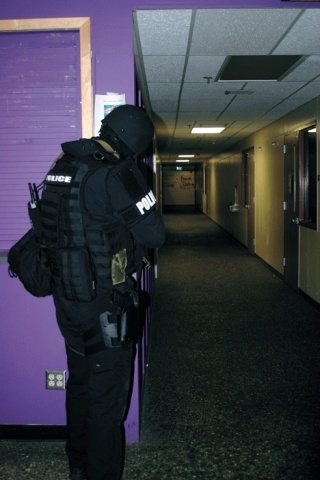High schoolers stood in the hallway clutching the walls as black-armored officers stampeded inside, shouting commands. The entry-team tried to discern between student and suspect, and stabbed the air with their guns. In a nearby classroom a gunman was holding 16 hostages.
“Run!” the squad ordered, and the disoriented students bolted to the Oak Harbor Lutheran Church parking lot, a temporary command post.
“That was kind of scary … but fun,” student Krista Holloman said.
The school “evacuation” was part of Monday night’s mass casualty drill that at times looked like the real thing.
As part of the simulation, the Oak Harbor Police Department received a call at 6:15 p.m. that a man had entered the high school armed. A handful of mock on-duty officers arrived on-scene, along with the Oak Harbor Fire Department and the Whidbey General Hospital Emergency Medical Services. The street was closed at each end of Second Avenue.
Lt. Craig Anderson with the Oak Harbor Fire Department said that before the infamous Columbine High School shooting in 1999, in which 12 students were killed, crews would first set up perimeters around the school. Now, in these cases, they make entry as soon as possible to find the killer before he can do more damage.
As more agencies amassed, police contained the “hostage” room, and firefighters began removing wounded victims from secured exits. Students were covered in realistic makeup to simulate gunshot wounds.
“A couple things happened from there. We had hostage negotiations involved and detectives came to get intelligence. They wanted to find out who this guy was and how many people were in there with him,” Lt. John Dyer said.
If requested, detectives could access school records of the supposed shooter, played by firefighter Rich Cuvas. The students who fled from the building added descriptions of the shooter and the weapon. They appeared shaken and distraught.
“We had scripts to look at beforehand, and we had to give genuine reactions,” Jared Ruefa said.
The agencies coordinated their efforts through a tactical frequency. Dyer described the “full-scale exercise” as a twist on typical command and control, which is usually done in car accidents.
“This gives us training in creating a unified command center and working together and individually,” he said.
Oak Harbor Police Chief Rick Wallace said cross communication is key, however, it can also be a stumbling block.
“We go into this knowing it will be hectic and that we’ll make mistakes, but it’s good to make them now,” Wallace said. “Sometimes they can be very small mistakes but they have a big impact down the road.”
Once the hiding and wounded students were escorted from the building and taken to a treatment area near the staff parking lot, negotiators convinced the “gunman” to release seven students. But soon, the standoff went south and simulators started “shooting,” Dyer said.
“Police entered the classroom and had to deal with the suspect, wounded students and other students,” he said. “They got everyone down and sorted out who was the bad guy.”
One by one, the unit uncradled the students, who were counted off and rushed into the hall. After some rejoicing, the agencies debriefed and team leaders discussed the positives and negatives of the hostage rescue. A more in-depth, written debrief will be completed later.
“This is so we can do better, because in any large scale situation, be it something weather-related or a building collapse, all agencies must work together,” Dyer said.
The students, who are members with Key Club, will receive community service credit for their efforts.



